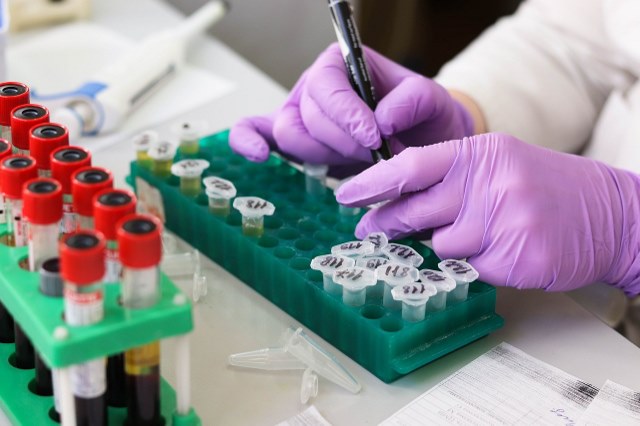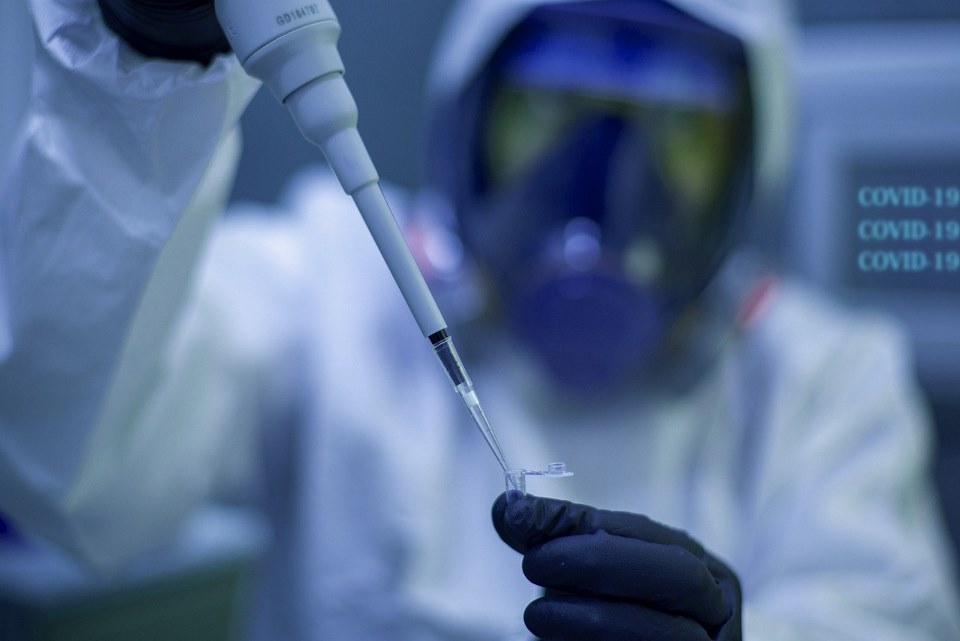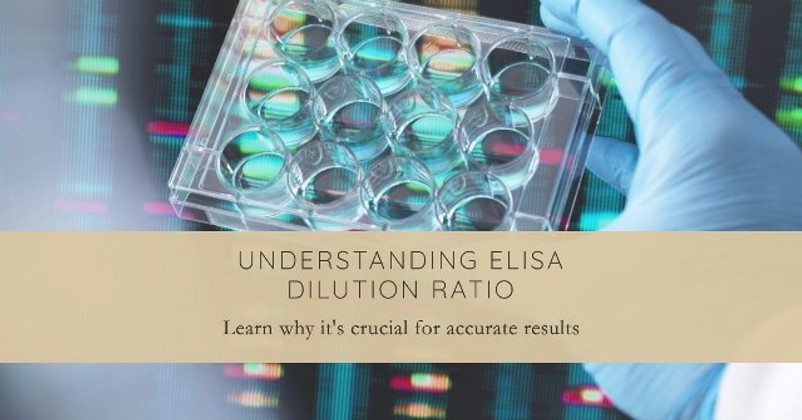What Is Elisa Dilution Ratio, And Why Is It Important?
Jul 27th 2023
What Is Elisa Dilution Ratio, And Why Is It Important?
Elisa kits are vital for quantifying and detecting diverse arrays of analytes that can attach to an antibody, like CD antigens, hormones, cytokines, apoptosis markers, growth factors, metabolites, etc.
ELISAs can be quantitative or qualitative. When the target analyte is detected in a specific assay-dependent detectable range, a qualitative test provides a yes/no response.
Quantitative ELISAs are much more valuable and popular than yes/no assays. They tell you how much and how concentrated a target analyte is in a particular specimen, which lets you do experiments like comparing samples from sick and healthy people.
Both essays can either be homemade or commercial. All the cell culture, linearity of dilution, dilution factor vs dilution ratio, and supernatant Elisa dilution play a vital role in such a process. You must constantly employ particular measures to ensure accuracy and high-quality data, whether store-bought or DIY ELISAs.
The dilution ratio is an essential factor to consider in each situation.
This guide details the Elisa dilution ratio and dives into why it's crucial for getting accurate and high-quality data.
What does Elisa Dilution Ratio mean?
Wondering what is the purpose of serial dilution in Elisa? An ELISA dilution ratio is the amount of sample that must be added to a specific volume of diluent before the ELISA test kits may be used. For instance, if the dilution ratio is 1:8, a single part of the sample must be added to 8 portions of diluent to get the desired final quantity of 9 parts.
Many factors contribute to the significance of this phase of first sample dilution. To get reliable and relevant findings, the sample must fall within a concentration range that can be observed by the particular ELISA test. If the quantity present in the sample falls beyond the range at which it can be identified, the assay might perform poorly, the samples might not be noticed, or it might produce inaccurate findings.
When trying to determine the best dilution ratio, there are a lot of different things that you have to take into account. It is easy to develop a ratio that improves the specificity and sensitivity of an ELISA test if one gives each factor the thoughtful consideration they require. In the end, this will ensure reliable findings.
How to Figure Out the ELISA Dilution Rate?

The degree of sensitivity and detection range of the assay, the quantity of the target antigen contained within the specimen, and the antibody's affinity employed in the assay to the antigen that will be detected are a few of the variables you must carefully assess when determining what dilution ratio to use for a given sample.
The following are some suggestions for how to achieve the best possible dilution ratio:
Alt Text – what is the purpose of serial dilution in elisa
- The sample should be extensively diluted at first (using a factor of 1:100 or 1:1000, for example). This means that even if the amount of target antigen in the specimen is low, the test can still pick it up because of its sensitivity.
- The next step is to study what happens when the sample is serially diluted (at concentrations such as 1:10, 1:100, 1:500, and 1:1000). The ELISA assay must be carried out precisely according to the manufacturer's directions for every evaluated dilution.
- It is possible to plot the data for each dilution, after which one can examine the contour of the curve.
- Suppose the slope is mostly flat and doesn't change much as the amount of dilution goes up. This will show that the test is sensitive enough and that the most concentrated solution may be used.
- Suppose the curve keeps rising noticeably at greater dilutions. Increasing the dilution ratio of the assay may increase its sensitivity. Given the current circumstances, it is recommended that the test be carried out once more with a series of growing dilution ratios (for instance, 1:2000, 1:4000, and 1:5000). After that, perform another round of the ELISA test, and pay attention to how the curve develops on the graph.
After carrying out the procedures above and analyzing the graph's curve shape, it is feasible to use an Elisa dilution calculator to determine an ideal ratio that, for the particular ELISA method currently being carried out, would produce the highest level of sensitivity and the most accurate findings.
What Influences the ELISA Dilution Ratio?
When determining the most effective dilution ratio to use when carrying out an ELISA (enzyme-linked immunosorbent assay), one must consider many parameters, all of which are significant in their own right.
Here we'll go into more detail about some more prevalent factors.
Assay Sensitivity: The sensitivity of an ELISA assay is defined as the lowest concentration of an antigen that the assay can identify.
Antibody-antigen affinity: it’s commonly understood that a lower dilution ratio corresponds to more significant attraction among the two molecules.
By striking the proper balance between the previously stated criteria, there is a way to get the best dilution ratio.
Antigen concentration: When working with small amounts of antigen, it's best to dilute it extensively. On the other hand, when there are a lot of antigens, it is best to have lower dilution ratios. Doing so will preserve the confidentiality of the information and the integrity of the results.
Why is the Optimal ELISA Dilution Ratio Important?
To maximize the benefits, you should use the optimal dilution ratio.
It will result in an increase in the assay's sensitivity and even make it possible to measure extremely low antigen concentrations in a particular sample. Since the target antigen only exists at low concentrations, this can be crucial when examining the early stages of many carcinomas. To identify this, the test requires setting up in the best way possible.
It could increase the assay's specificity. Any false positive or false negative results will be avoided as a result. When investigating potentially fatal medical issues, this can be highly important. It will produce more accurate outcomes that are reliable, repeatable, and consistent.
Moreover, this can bring down the cost by cutting down on the number of chemicals and materials that will be needed. Additionally, the amount of waste that must be disposed of can be reduced drastically.
Now, let's consider some practical examples.
Directions for performing a Dilution Series
All the commercially available antibodies come with a comprehensive data sheet that explains the antibody type, the concentration of the combination, or the amount of lyophilized powder included in the package. If the powder were lyophilized, the data sheet would also have details on the other constituents present in the solution from which it was extracted.
These extra elements are salt buffers maintained at a specific pH and other additions like trehalose. The data sheet will have directions for reconstitution, but you can change these depending on your requirements and purpose.
This data sheet typically also suggests dilutions or concentrations for varying uses, like ELISA or western blot. Thus, while carrying out a custom antibody dilution series for a specific application, you must incorporate the suggested concentration in addition to two dilutions lower than that quantity and two dilutions approximately that amount. For instance, if a datasheet recommends adopting a dilution of 1:200, you should produce 1:50, 1:100, 1:200, 1:400, and 1:500 dilutions before beginning your experiment.
How to Dilute at a Ratio of 1:50?

Is the Dilution Ratio and Dilution Factor The Same?
No, although the difference can be insignificant in some situations.
The term "dilution factor" refers to the proportion between the solute's initial volume and the solution's total volume after diluting it (Vsolute multiplied by Vsolvent equals Total Vsolution).
When doing repeated dilutions, the dilution factors are of crucial significance.
Therefore, a dilution factor of 1:4 represents one component solute dissolved in four parts solvent, which results in four total parts. The end volume equals the sum of the solute and solvent volumes.
To recap, how does ELISA function?
Thinking how to do serial dilution in Elisa? Assume you wish to discover a specific protein in a blood sample:
Direct immobilization of the desired protein or antibody that identifies it to an assay plate is one option, while indirect immobilization via a capture antibody coupled to the assay plate is another.
The principal antibody identifies an epitope on the protein you are interested in finding in the blood sample.
A secondary antibody-enzyme combo attaches the primary antibody or the protein of interest itself. Then it interacts with a substrate to give a signal that can be detectable using a spectrophotometer, fluorometer, or luminometer, contingent upon the assay format. This binding can take place in either direction.
Where Does an ELISA Standard Come into Play?

As mentioned earlier, there are quantitative and qualitative ELISAs. A sample's presence or absence of a target analyte is reported as yes or no based on the detection limits of the specific assay used.
Standards are not necessary for qualitative tests, commonly read through comparing unknown samples to either a sample-free well on the assay plate or an independent positive control sample with an established amount of the desired analyte.
However, standards become relevant when quantifying anything using an assay. Compared to yes/no assays, quantitative ELISAs are significantly more effective and widespread. They can enable you to compare samples from healthy and diseased individuals and research how dietary habits, pH changes, medication use, and other factors influence analyte levels.
Use the Proper Standards
Using dilution ratios in quantitative ELISAs in research and clinical settings is highly beneficial, but only if the assays are validated against rigorously established reference standards. To generate a standard curve, most commercially accessible ELISA kits now come with standard preparations.
If this is the case, the Elisa kit manufacturers will additionally include instructions for the proper dilution and dealing with the standards to assist you in achieving the best outcome achievable.
If you need to test a molecule for which no kit exists, such as a recently discovered hormone or rare metabolite, you must prepare your own assay and source standards. When developing ELISA standards, the following sections discuss the most critical factor you should consider.
Standard Type and Source
You should make the standard curve using a purified sample of the analyst measured, such as an aliquot of the protein of interest in its purest form. You may get this from a seller who proves it is pure. Lyophilized aliquots (powder) of commercial standards are typically shipped along with lot-specific directions for reconstitution.
Suppose the analyte of interest is unavailable for sale. In that case, you have two options: you may choose to purify it on your own, or you may employ a recombinant variant and then test the purity of the analyte using HPLC or another chromatographic technique.
When attempting to quantify the concentration of 'homemade' standards, employing all-in-one protein quantification techniques such as the Bradford assay is not recommended because these standards are unlikely to be entirely pure.
Conclusion
It is essential to determine the appropriate dilution ratio to accurately measure the concentration of the unidentified antigen within the supplied sample. You can achieve this by doing the necessary calculations. In addition, this will make the testing technique more sensitive while increasing its specificity.
Also, remember that it is necessary to avoid conflating the terms "dilution ratio" and "dilution factor." Both terms are usually shown as ratios, making them hard to tell apart. In other words, if you ask two people to dilute a sample, you'll get two results.
As a consequence, it’s always advised to consult an enterprise who’ve achieved significant heights in the field of gene synthesis, protein production service, antibody sequencing, antibody production, and many more. And when that’s the case, Biomatik is an ideal option.

